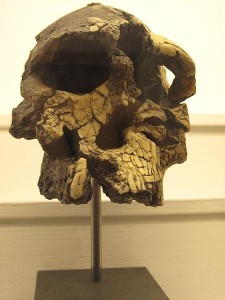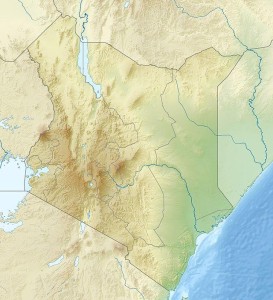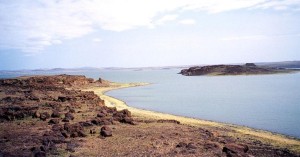Part III: Pliocene Epoch
13. Kenyanthropus platyops
Kenyanthropus platyops (3.5 mya)
(“Kenyan human” / “flat-faced”)

SITES
Lake Turkana, Kenya
PEOPLE
Meave Leakey
INTRODUCTION
A surprisingly “flat-faced” hominin came to light with Meave Leakey’s discovery and naming of Kenyanthropus platyops (“flat-faced human from Kenya”) in 1999. The degree of orthognathism was surprising for such an early hominin.
PHYLOGENY
Since the skull was crushed and reconstructed (see Figure 13.1), some paleoanthropologists discount the degree of orthognathism and would like to see the specimen assigned to genus: Australopithecus, and possibly to species: afarensis. Others feel that it is the base of our lineage, believing that a cladistic event occurred at Au. afarensis, leading on the one hand to the robust forms (including Au. africanus) and on the other hand toward humans. In the latter case, some would like to see K. platyops assigned to genus: Homo, believing it to be the ancestor of Homo rudolfensis, with which it shares a similar orthognathic profile. Of interest is that some have speculated that the species may have made the Laetoli footprints. However, if the platyops fossils really belong in Au. afarensis, it would not be news!

DISCOVERY AND GEOGRAPHIC RANGE
K. platyops is known only from a site in the West Lake Turkana region of Kenya (see Figures 13.2 and 13.3), where Meave Leakey’s team found the crushed skull in 1999. The hypodigm consists of a reconstructed skull, plus two partial maxillae and a temporal bone from other individuals.

PHYSICAL CHARACTERISTICS
While possessing primitive ape-like molars (elongated mesiodistally, i.e. front to back) and sharing similarities with Au. anamensis and afarensis, the lower face of K. platyops is surprisingly (and possibly mistakenly) orthognathic for its early date. The cranial capacity of K. platyops is also suspect due to the reconstruction but if accurate, it was fairly high relative to other species of the time, at 400–500 cc.
Review of Primitive Characteristics
- Elongated ape-like molars.
Review of Derived Characteristics
- Possibly more orthognathic.
- Possibly encephalized relative to previous and contemporary species.

